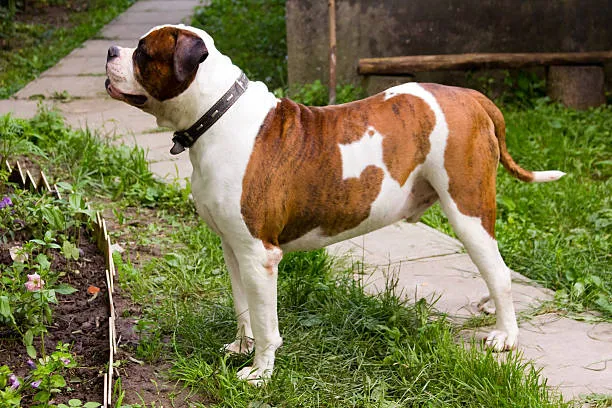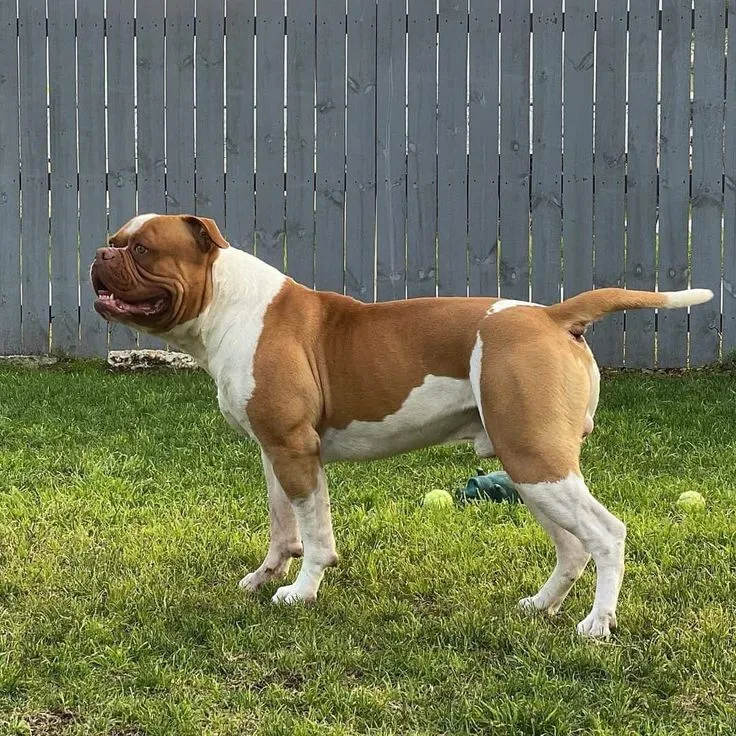The American bulldog Johnson breed is a bodybuilding bulldog in the world of chihuahua contests. These dogs are the embodiment of power, from their mighty bodies, wide shoulders, and robust jaws to their rugged frames.

But don’t let that steely look fool you; underneath that whole bulk lies a heart of gold! With this awesome information, you learn the rich history and features of the American bulldog Johnson.
So you’ll know why these gentle giants are unique. Keep reading to learn more regarding this American bulldog Johnson breed.
What Makes the American Bulldog Johnson Breed Unique?
What distinguishes the American Bulldog Johnson breed from other breeds? Since their physical powers are most impressive:
American Bulldog Johnsons are athletic, with a broad chest, thick legs, and a strong stance. They can run, jump and play with active families like their best.
An impressive bite power in winning fights, few guards can wield a force as strong as it does. Therefore, few guard breeds could pry it from such an assignment should it wish to attend to them.
Despite their rugged appearance, American Bulldog Johnsons are intelligent and eager to please.
They are very teachable and can learn any command or trick with sufficient training, which makes them highly adaptable in any home.
Nonetheless, these dogs are devoted and loving to their families. They desire human interaction and only wish to be loved, especially when cuddled on the couch with their favourite people.
History of the American Bulldog Johnson Breed

In England, bulldogs were traditionally used as working dogs, driving and catching livestock and guarding their masters’ properties.
The breed’s strength, courage, and familiarity with animals made it famous in the cruel pastime of bull baiting.
When this sport was banned in England, the original type of Bulldog vanished, to be replaced by the shorter, stockier, and less athletic dog known as the English Bulldog today.
Nevertheless, working-class immigrants who carried their working dogs to the American South saved the original Bulldog. Small farmers and ranchers used this all-purpose working dog for a variety of activities.
However, by the end of World War II, the breed had practically become extinct. Mr. John D. Johnson, a returning war veteran, decided to restore the breed.
Johnson, along with Alan Scott and several other breeders, began carefully breeding American Bulldogs, keeping meticulous records and always maintaining the breed’s health and working ability.
Since this breed can do a wide range of tasks, numerous separate lines have emerged, each highlighting the characteristics required for a certain profession. The best-known lines are sometimes referred to as Johnson and Scott kinds.
Scott dogs, also known as standard dogs, are more of a performance style, athletic dog with a sleeker appearance than bully dogs. They have less bone, longer muzzles, a more mild halt, and a less pronounced undershot bite.
Today, however, many American Bulldogs have crosses to two or more of the original lines and are classified as hybrids, meaning they have features from more than one of the original bulldog lines.
The Johnson dogs, often known as bullies, have a bigger build, heavier bone structure, larger heads with more stops, a shorter muzzle, and a more pronounced undershot bite. They tend to have larger muscle mass as well.
The modern American Bulldog remains a versatile working dog, a courageous and steadfast guard dog, and a devoted family companion.
The American Bulldog was officially recognized by the United Kennel Club on January 1, 1999.
General Appearance of American Bulldog Johnson Breed
The American Bulldog is a muscular, athletic, short-coated dog with a solid build and good bone structure. The body is only slightly longer than tall. The head is huge and broad, with a prominent muzzle.
Ears are small to medium-sized, high-set, and can be dropped, semi-prick, rose or clipped. The tail can be docked or natural. The American Bulldog comes in three colours: solid, white with coloured patches, and brindle.
Gender differences are noticeable in this species, with males being larger and more muscular than females.
Respectable scars from fieldwork will not be penalized. The American Bulldog should be judged as a working dog, with exaggerations or flaws punished in proportion to their impact on the dog’s ability to work.
The American Bulldog Johnson Breed Characteristics

The American Bulldog’s essential traits include the ability to work as a hog and cattle catcher, as well as a personal property protector.
These tasks necessitate a strong, nimble, and confident dog with a huge head and powerful jaws.
The American Bulldog is a kind, loving family pet who is brave enough to confront an enraged bull or a human invader.
Note: It is common for young American Bulldogs to be reserved with strangers, and judges should not penalize this.
However, by the time the dog reaches 18 months of age, the breed’s natural confidence has emerged.
Disqualifications include viciousness, severe shyness, and cowardice.
Head
The head is huge and broad, creating the impression of enormous might. When viewed from the side, the skull and muzzle are parallel and connected by a well-defined stop.
The stop is extremely deep and sudden, practically at a straight angle to the muzzle. Regardless of the depth of the stop, the forehead is wider than it is tall.
SKULL
The skull is big, flat, deep, and wide between the ears. From the top, the skull seems square.
There is a deep median furrow that decreases in depth from the stop to the occiput. The cheek muscles are prominent.
Bully dogs’ skulls are often box-shaped to rounded, with a more distinct stop and more wrinkles than standard breeds, which have box or wedge-shaped skulls.
An abnormally thin skull, regardless of type, is a serious fault.
MUZZLE
The muzzle is large and thick, with only a small taper from the stop to the nose. The muzzle length in bully-type dogs ranges from 25 to 35 per cent of the entire length of the head.
In standard dogs, it accounts for 30 to 40% of the overall length of the head. The jaws are powerfully muscled and show remarkable strength.
Lips are medium thick but not pendulous. Black lip pigment is preferable. The chin is well-defined and should not overlap or cover the upper lip.
Serious Fault: Any form of muzzle that is extremely narrow.
Disqualification: Any dog that has difficulties breathing while in the ring.
TEETH
The American Bulldog has a full set of 42 massive, regularly spaced white teeth. The conventional variety prefers a reverse scissors bite, however, a scissors bite or a mild underbite (up to an inch) is acceptable. An even bite is OK, but not recommended.
In the bully type, an undershot of about an inch is preferable, although any variance between 1/8 inch and an inch is acceptable.
An even bite is OK, but not recommended. An excessive undershot bite is considered defective if it impairs the dog’s ability to work. Teeth are not visible when the mouth is closed. Worn or broken teeth are okay.
Disqualification: Overshoot. Wry expression.
NOSE
The nose is big, with wide and open nostrils. Black is the preferred hue, however tints of red and brown are acceptable. Lack of pigmentation is a cosmetic flaw.
The eyes are medium-sized, round to almond-shaped, and well-set apart. All hues are allowed, though dark brown is preferred. How isn’t visible? Black eye rims are desirable.
Faults: Evident haws.
Disqualification: Crossed eyes. Eyes of different colours.
EARS
Ears can be cropped, but natural ears are desirable. Natural ears are small to medium-sized, high-set, and can be dropped, semi-prick, or rose.
Drop ears: The ears are raised high, level with the upper line of the skull, emphasizing the skull’s width.
At the base, the ear is somewhat elevated in front and hangs down the cheek. The tips are somewhat rounded. When pulled toward the eye, the ear should not extend beyond the outer corner of the eye.

